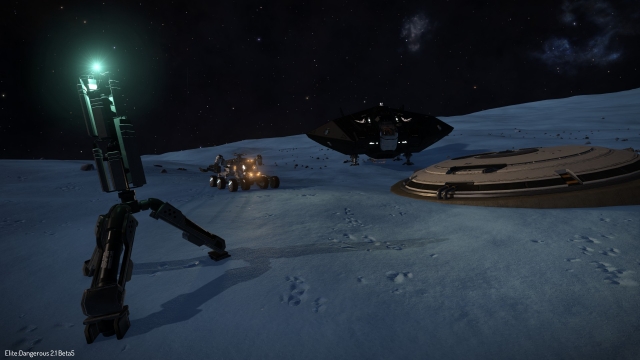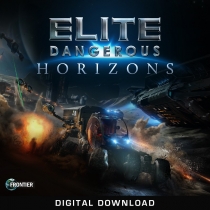
Elite Dangerous: Horizons - The Engineers Preview
The first major patch release, 2.1: The Engineers, for Elite Dangerous: Horizons is here after a longer than expected gestation period. What does it add and was it worth the extended wait?
The main addition are the engineers themselves, who are able to upgrade ship modules in a variety of ways and potentially give your weapons some unique effects. You start with a handful of engineer locations open to you and as you deal with these eccentric folk they’ll reveal more to you.

Each engineer specialises in a particular area, “The Dweller” for example will upgrade power distributors and pulse lasers. Before they’ll deal with you though you have to get in their good graces. What this involves depends on the Engineer, some just want credits or a certain commodity, others might want bounty bonds or exploration data.
When satisfied they’ll give you access to their upgrades, these are organised in tiers of blueprints, with the higher tiered ones requiring more and rarer components. These upgrades typically trade off one or two statistics for the benefit of another, for example increased FSD (Frame Shift Drive) range might trade reliability for less mass and power draw.
 Once you've fulfilled a blueprint you’ll see the above screen, showing the potential ranges of the upgrade. After the primary effects are determined there is a chance, depending on the tier, of getting secondary effects applied too. The higher the tier, the less negative effects there are. Finally if you are upgrading a weapon you have a chance for a special effect to be applied, in this case Thermal Shock.
Once you've fulfilled a blueprint you’ll see the above screen, showing the potential ranges of the upgrade. After the primary effects are determined there is a chance, depending on the tier, of getting secondary effects applied too. The higher the tier, the less negative effects there are. Finally if you are upgrading a weapon you have a chance for a special effect to be applied, in this case Thermal Shock.
These special effects are numerous and include some interesting mechanics beyond the expected “elemental”-style effects like Corrosive Shells or Incendiary Rounds. Thermal Conduit for example increases your damage based on your heat level and Concordant Sequence increases a wingman’s shield regeneration.
This system certainly shakes up the status quo with regards to ship loadouts: with some perseverance you can make some drastic changes making lesser used ships much more viable now. Ships can become more specialised or extend their multi-role nature with an upgrade to a couple of systems. A Vulture becomes far more dangerous with an upgraded power plant for example. The inclusion of support effects like shield healing lead to new gameplay styles and something more to consider for group play.
 As well as the addition of the engineers there has also been a huge amount of work done to the mission system; the most obvious change is the persistent NPCs giving you the missions. Having a face attached to them makes a huge difference from an immersion perspective and it’s well overdue.
As well as the addition of the engineers there has also been a huge amount of work done to the mission system; the most obvious change is the persistent NPCs giving you the missions. Having a face attached to them makes a huge difference from an immersion perspective and it’s well overdue.
The overall redesign of the bulletin board surfaces a lot of stuff you’d previously have to dig around for: it’s a lot more apparent what your rewards are, where you are expected to go and what faction you are doing it for. This new philosophy follows through into the mission screen itself.
 Prior to this update the mission descriptions could be described as vague at best, unintuitive and misleading at worst. The new layout makes what is expected of you much clearer and even offers tips and things to be aware of, again making rewards and important information clearly visible. This continues into other interface elements like the Inbox and Transactions tab in your cockpit providing a nice consistent feel.
Prior to this update the mission descriptions could be described as vague at best, unintuitive and misleading at worst. The new layout makes what is expected of you much clearer and even offers tips and things to be aware of, again making rewards and important information clearly visible. This continues into other interface elements like the Inbox and Transactions tab in your cockpit providing a nice consistent feel.
The mission changes extend beyond just interface messaging though. Structurally all the mission types have had a quality pass, many more missions now use the inbox to provide secondary options or alternative choices mid-mission, even the regular A to B delivery can now have an optional bonus reward for arriving within a certain timeframe. Frontier are calling these “mission wrinkles” and they hope to add more going forward.
These changes help to make missions feel more dynamic and rewarding, that you are doing them for a “person” rather than just a lump of text also helps a great deal. The portraits bring some humanity to the often very stark and clinical world of Elite and they also bring pangs of nostalgia for the two prior games in the series.
 Those are the two headline features of this update but there are so many other tweaks and new features, one of the most requested and useful ones being the bookmarking feature. This finally allows you to mark any system (or celestial body within a system) with a little note and have it show up on the galaxy map. Once made you can edit it or even plot a route to it. Such a handy thing that should’ve been there from the beginning.
Those are the two headline features of this update but there are so many other tweaks and new features, one of the most requested and useful ones being the bookmarking feature. This finally allows you to mark any system (or celestial body within a system) with a little note and have it show up on the galaxy map. Once made you can edit it or even plot a route to it. Such a handy thing that should’ve been there from the beginning.
Also useful is the fact that Community Goals are now fully discoverable and visible in-game without needing to visit external sources like the games launcher or the games newsletter. They show up both in the redesigned Bulletin Board/Mission screen as well as on the Galaxy Map.
Gameplay improvements have been made to how Unknown Signal Sources (USS) work; by scanning them you can now see a basic description of what is within as well as a threat level to help you decide whether to look at it or not. Mission specific USS as well as planetary points of interest also work differently now. Scanning a Nav Beacon in a system nets you basic directions to where they’ll be and they now also show up in a different colour!
Performance and graphics have also been looked at, asteroid belts have had another pass with fog/haze improvements, planets now look much more detailed and snow and dirt have a more fluffy/soft feel to them. The SRV (Surface Recon Vehicle) now leaves tracks behind it and performance on planetary surfaces is noticeably better.
Along with the graphical updates there are aural treats as well, we finally have the space station equivalent of air traffic control. Radio chatter informing you of docking procedures, much like the character portraits on the bulletin board, helps with immersion and staves off some of the sterility in the world.
Other changes are varied, new enemy behaviour, new weapon sizes (Huge Multi-cannons, Lasers), more traffic on planet surfaces, other galaxy map improvements like seeing system states (War, Famine, Boom and the like) and so many more little things.
 All in all there is a lot to like about this update, ironically the main engineer crafting mechanics themselves could be Marmite-like in that the level of randomness could be a pro or a con depending on your perspective and how much you like gathering components. But the rest of the update is hard to fault overall just due to the sheer amount of tweaking and polish that’s been applied to almost every facet of the game.
All in all there is a lot to like about this update, ironically the main engineer crafting mechanics themselves could be Marmite-like in that the level of randomness could be a pro or a con depending on your perspective and how much you like gathering components. But the rest of the update is hard to fault overall just due to the sheer amount of tweaking and polish that’s been applied to almost every facet of the game.
Of note however is that everything bar the engineers and planet related changes trickle down into the base Elite: Dangerous game with patch 1.6 that will go live at the same time. Which shows Frontier’s commitment to improving the game for everybody but it does lessen the impact of the update as far as Horizons specific stuff goes.
Are the crafting and planetary changes enough to push more folk to purchase Horizons if Planetary Landings weren't enough of a draw? That’s hard to say, but the amount of work that has been put in bodes well for future updates to the Horizons “season.”
Elite Dangerous: Horizons - The Engineers goes live for PC owners of Horizons on 26th May. Elite Dangerous: Horizons is available via Steam or the Frontier Store for £19.99/$29.99/€24.99.
Xbox One owners will also have access to both Planetary Landings and The Engineers when Horizons launches on 3rd June for £19.99/$29.99/€24.99.










COMMENTS
Acelister - 08:59pm, 28th May 2016
Love it. This preview held me over while the update finally landed, and now I love the update.
The Mission screen looks fantastic.
pucechan - 10:07pm, 28th May 2016 Author
Glad you liked the preview! :) I think the Interface changes make such a big difference but my favourite feature by far is the flight control chatter, it always makes me smile! The sheer amount of variation in the voices and lines has surprised me!
So many cool little things in the update, nice to see enemy AI put up more of a challenge now too!